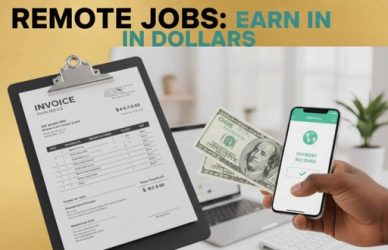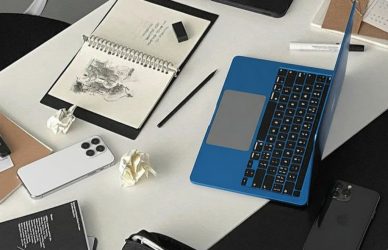In today’s digital era, product design is one of the most exciting and in-demand fields. Companies worldwide are continually seeking talented product designers to create user-friendly and visually appealing products. The rise of remote work has made it possible for Nigerians to secure these roles from the comfort of their homes. Whether you’re an experienced designer or looking to break into the field, this guide will help you navigate the path to landing a remote product design job.
Why You Should Consider Transitioning into Product Design
Product design is a field that blends creativity with functionality, offering a dynamic and fulfilling career.
According to the U.S. Bureau of Labor Statistics, the employment of graphic and product designers is projected to grow 3% from 2020 to 2030, adding thousands of new jobs.
Additionally, LinkedIn’s “Jobs on the Rise” report lists UX/UI design as one of the top emerging jobs globally. The demand for product designers is driven by the need for companies to enhance user experience and remain competitive in the market.
Skills Needed to Succeed in Product Design
To excel in product design, you need a combination of technical and soft skills:
Technical Skills:
- UX/UI Design: Understanding user experience (UX) and user interface (UI) principles to create intuitive and engaging designs.
- Prototyping and Wireframing: Using tools like Sketch, Figma, Adobe XD, and InVision to create prototypes and wireframes.
- Graphic Design: Strong graphic design skills to create visually appealing interfaces.
- Coding Basics: Knowledge of HTML, CSS, and JavaScript can be beneficial.
- User Research: Conducting user research to inform design decisions.
Soft Skills:
- Creativity: Developing innovative design solutions.
- Communication: Effectively communicating design ideas and collaborating with team members.
- Empathy: Understanding and addressing user needs and pain points.
- Problem-Solving: Identifying and resolving design challenges.
- Attention to Detail: Ensuring precision in design work.
Recommended Resources for Learning Product Design Basics
Learning the basics of product design can take anywhere from a few months to a year, depending on your dedication and prior experience.
Here are some recommended resources to get you started:
YouTube Channels:
- The Futur: Offers tutorials and advice on design and business.
- AJ&Smart: Provides insights on design sprints and UX design.
- DesignCourse: Covers a wide range of design topics and tools.
- CharliMarieTV: Focuses on design principles and portfolio tips.
Online Courses:
- Coursera: Offers courses like “UI/UX Design Specialization” from the California Institute of the Arts.
- Udemy: Provides affordable courses such as “User Experience Design Fundamentals.”
- Interaction Design Foundation: Offers comprehensive courses on various aspects of UX/UI design.
- LinkedIn Learning: Provides a wide range of design courses and tutorials.
By dedicating consistent effort and using these resources, you can quickly gain the foundational knowledge needed to start your product design career.
Steps to Landing a Remote Product Design Job from Nigeria
Step 1: Assess Your Skills and Interests
First things first, you need to know what you bring to the table. Product design is a multifaceted field, so it’s crucial to identify your strengths and areas for improvement.
Start by researching the most sought-after skills in product design, such as UX/UI design, prototyping, wireframing, and user research. Understanding these key areas will help you focus your learning and development efforts.
Self-assessment is a vital part of this process. Take stock of your current skills. Are you great at creating visually appealing designs, or do you excel at understanding user behavior and needs?
Use online tools and self-assessment quizzes to get a clear picture of your strengths. Reflect on past experiences, whether from jobs, internships, or personal projects, to evaluate your competencies and identify any skill gaps.
Finally, setting goals based on your assessment will provide direction. Decide which skills you want to develop or enhance. Create a plan outlining how you will acquire these skills, whether through courses, certifications, or practical experience.
Having clear objectives will keep you motivated and focused as you prepare to enter the remote product design job market.
Step 2: Gain the Necessary Skills
Once you’ve assessed your skills, it’s time to fill in any gaps. Fortunately, there are plenty of resources available online to help you learn and grow.
Online courses and certifications are excellent ways to gain new skills and validate your expertise. Platforms like Coursera, Udemy, and LinkedIn Learning offer a plethora of courses in various design fields.
Certifications from reputable sources can significantly boost your resume and make you more attractive to potential employers.
In addition to formal courses, self-study resources and community groups are invaluable. Utilize free resources such as blogs, YouTube tutorials, and design forums.
These platforms provide up-to-date information and practical tips from industry experts.
Joining community groups on LinkedIn or Facebook can also provide support and additional learning opportunities.
Engaging with peers and professionals can help you stay motivated and informed about industry trends.
Practical experience is just as important as theoretical knowledge. Apply what you learn by working on real or simulated projects. Create your own design projects, conduct user research, and build prototypes. Practical application of your skills will build your confidence and enhance your portfolio, demonstrating your ability to prospective employers.
Step 3: Build a Strong Portfolio
Your portfolio is your design showcase. It’s where potential employers can see your skills in action.
A well-curated portfolio can set you apart from other candidates by providing tangible proof of your abilities. Include examples of your best work, such as app interfaces, website designs, prototypes, and user research findings.
Highlight the results and impact of your work to show your effectiveness.
Diversify the types of projects in your portfolio to demonstrate your versatility. Make sure to include a variety of projects that highlight different skills.
For instance, if you’ve designed a successful app interface, include details about your design process, user feedback, and final outcomes. If you’ve conducted user research, showcase your methodologies and findings.
Each piece should tell a story about your approach and the value you brought to the project.
Keep your portfolio updated and professional. Use platforms like Behance, Dribbble, or a personal website to display your work. Ensure each project is well-documented with clear descriptions and visuals.
Regularly update your portfolio with new projects and achievements to reflect your growth and keep it relevant. A dynamic portfolio will attract potential employers and demonstrate your ongoing commitment to your field.
Step 4: Networking and Community Involvement
Networking is a powerful tool in your job search arsenal. Being active in design communities can open doors to job opportunities and valuable connections.
Join design communities and forums like Reddit’s r/user experience, LinkedIn groups, and other professional communities.
These platforms are great for networking, learning, and staying updated on industry trends.
Participating in discussions and sharing your insights can help you build a reputation and connect with like-minded professionals.
Attending virtual design events and webinars is another excellent way to expand your network. Engage with virtual events, webinars, and workshops.
These events are excellent for learning from industry experts and expanding your network. They provide opportunities to ask questions, gain new perspectives, and stay informed about the latest developments in design.
Many events also offer networking sessions where you can meet potential employers or collaborators.
Building relationships through networking requires consistent effort. Follow up with people you meet, join ongoing conversations, and offer your assistance or expertise when appropriate.
Networking is not just about taking; it’s about giving and building mutually beneficial relationships.
As you become more involved in the design community, you’ll find more opportunities to showcase your skills and discover job openings that may not be advertised publicly.
Step 5: Tailoring Your Resume and Cover Letter
Your resume and cover letter are often your first impression on potential employers. Make sure they are tailored to highlight your design prowess.
Focus on the skills and experiences that are most relevant to the job you’re applying for. Use metrics and specific examples to demonstrate your impact.
For instance, instead of just stating you designed a mobile app, mention how your design improved user engagement by a certain percentage.
Personalize your cover letter for each application. Address the hiring manager by name, and clearly explain why you’re a perfect fit for the role and how you can contribute to the company’s success.
Highlighting your understanding of the company’s needs and how your skills and experiences align with their goals will make your application stand out.
A well-crafted cover letter can provide context to your resume and create a compelling narrative about your professional journey.
Consistency and professionalism in your resume and cover letter are crucial. Use a clean, readable format and proofread carefully to avoid any errors.
Ensure your contact information is up to date and matches across all your application materials.
Tailoring each application to the specific job description, following up on your applications, and being prepared to demonstrate your skills in action during interviews will significantly improve your chances of landing a remote product design job.
Step 6: Applying for Remote Product Design Jobs
Now that your resume and cover letter are ready, it’s time to start applying for jobs. Some of the best platforms to find remote product design and other jobs include Remote.co, We Work Remotely, FlexJobs, LinkedIn, and of course, Workfromhome.ng.
These platforms offer a wide range of job listings from reputable companies looking for remote talent.
Regularly check these sites and set up job alerts to stay updated with the latest opportunities.
Tailoring each application to the job description is crucial. Highlight the skills and experiences that are most relevant to the role.
Use keywords from the job posting to ensure your application gets through applicant tracking systems.
Following up on your applications shows your interest and initiative. A polite follow-up email a week or two after applying can keep you on the employer’s radar.
Standing out in the application process requires a combination of preparation and persistence.
Be prepared to demonstrate your skills in action during interviews or through portfolio reviews.
Practice common interview questions, and have examples ready that showcase your achievements and problem-solving abilities. By showing your enthusiasm for the role and your preparedness, you can make a strong impression on potential employers.
Step 7: Preparing for Remote Interviews
Getting an interview is a significant step, but preparation is key to success. Be ready to discuss your previous work, how you handle remote work challenges, and your specific design skills.
Practice answering common questions and be ready to provide examples. Familiarize yourself with the company’s products, services, and culture to show your interest and knowledge.
Ensure your technical setup is reliable for remote interviews. Make sure your internet connection is stable, your workspace is quiet, and you’re familiar with the interview platform.
Test your equipment ahead of time to avoid any technical difficulties. Dress professionally and ensure your background is clean and free from distractions. These details contribute to a positive impression.
Technical and non-technical interview tips include speaking clearly and confidently about your skills and experiences.
Maintain good eye contact through the camera, listen carefully to the interviewer’s questions, and take a moment to think before you respond.
Follow up after the interview with a thank-you email to express your appreciation for the opportunity and reiterate your interest in the position. This shows professionalism and reinforces your enthusiasm for the role.
Conclusion
Securing a remote product design job can open up a world of opportunities, allowing you to work flexibly and connect with international companies.
By following these steps, you’ll be well on your way to landing a remote product design role that matches your skills and career goals. For additional resources and support, sign up on workfromhome.ng and join a community of professionals successfully navigating the world of remote work.
Embrace the future of work and take the first step towards your remote career today!




